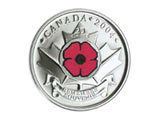
|
| ©n/a |
Canada's harmless poppy quarter has given some suspicious U.S. army contractors red faces after it was revealed they filed espionage accounts on the world's first coloured coin.
The contractors came across the 25-cent coin, which features the red inlaid image of a poppy over a maple leaf, while travelling in Canada.
The contractors described the suspicious coins as "anomalous'' and "filled with something man-made that looked like nano-technology,'' some once-secret U.S. government reports and emails said.
"It did not appear to be electronic (analog) in nature or have a power source,'' one U.S. contractor wrote after he found the coin in the cup holder of a rental car.
"Under high-power microscope, it appeared to be complex consisting of several layers of clear but different material, with a wire like mesh suspended on top.''
The technology they referred to was actually a protective coating the Royal Canadian Mint applied to the coins to ensure the poppy's red colour couldn't be removed.
Nearly 30 million poppy coins were produced by the mint in 2004 to commemorate Canada's 117,000 fallen soldiers.
The classified accounts lead to warnings from the U.S. Defence Security Service, an agency of the Defence Department, that the quarters contained radio frequency transmitters and were strategically planted on U.S. contractors.
One contractor was so suspicious of the red coins that he believed someone has planted two quarters in his coat pocket after he had emptied the contents of his coat hours earlier.
"Coat pockets were empty that morning and I was keeping all of my coins in a plastic bag in my inner coat pocket,'' the contractor wrote.
Canada's senior intelligence officers were annoyed with the U.S. espionage warnings.
"That story about Canadians planting coins in the pockets of defence contractors will not go away,'' Luc Portelance, now deputy director for the Canadian Security Intelligence Service, wrote in an email.
"Could someone tell me more? Where do we stand and what's the story on this?''
Intelligence experts believed the warnings, which stated the quarters could be used to follow the whereabouts of contractors with high-level clearance, were ridiculous when the information was first released.
"I thought the whole thing was preposterous, to think you could tag an individual with a coin and think they wouldn't give it away or spend it,'' H. Keith Melton, a leading U.S. intelligence historian, said.
However, Melton said the army contractors were only doing their jobs when they reported their suspicious findings.
"You want contractors or any government personnel to report anything suspicious,'' he said.
"You can't have the potential target evaluating whether this was an organized attack or a fluke.''
The Defence Security Service has since renounced its warning about spy coins but this is the first time that details of the embarrassing accounts have been made public.
The U.S. government said it performed an internal review to determine why the false information was included in a 29-page published report detailing espionage concerns.
The coins were never actually examined by the Defence Security Service.
"We know where we made the mistake,'' Cindy McGovern, a Defence Security Service spokesperson, said.
"The information wasn't properly vetted. While these coins aroused suspicion, there ultimately was nothing there.''
Some of the U.S. documents obtained by the Associated Press were deemed "Secret/Noforn,'' meaning the documents were never supposed to be seen by foreigners.
Many passages in the report were censored, citing national security reasons, before it was turned over under the U.S. Freedom of Information Act.
Next to one blacked-out section of the report was the cautionary sentence, "This has not been confirmed as of yet.''
The Canadian intelligence documents, which also were censored, were released under the Access to Information Act citing protection against subversive activities.



Reader Comments
to our Newsletter